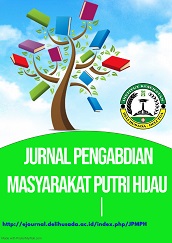EDUKASI FAKTOR RESIKO ERGONOMI PADA PEKERJA PEMANEN KELAPA SAWIT PADA PTPN IV UNIT USAHA ADOLINA DI BATANG TERAP KECAMATAN PERBAUNGAN KABUPATEN SERDANG BEDAGAI SUMATERA UTARA
EDUKASI FAKTOR RESIKO ERGONOMI PADA PEKERJA PEMANEN KELAPA SAWIT PADA PTPN IV UNIT USAHA ADOLINA DI BATANG TERAP KECAMATAN PERBAUNGAN KABUPATEN SERDANG BEDAGAI SUMATERA UTARA
Abstract
Ergonomic hazards arise when the nature of the job, bodily posture, and working environment impose strain on the body.
According to the findings of an initial survey conducted on 8 workers in the harvest area, it was observed that the workers experienced complaints. Specifically, 7 workers reported experiencing problems in various parts of their body, with the most significant complaints being in the back, arms, neck, and legs. The research design employed was quantitative, utilizing a cross-sectional method. This investigation was conducted in Batang Terap, Perbaungan Sub- District, Serdang Bedagai district. The population for this study consisted of 40 oil palm harvesting workers in afdiling 2, Perbaungan Sub-District, Serdang Bedagai Sub-District. The sample for this research was determined using a technique called complete sampling.
The result of this study findings indicate that there was significant statistical correlation between work posture (p = 0.001), workload (p = 0.005), frequency (p = 0.032), and work duration (p = 0.012). Specifically, poor work posture has the potential to increase ergonomic risks by 15 times in the share of the palm oil harvest in PTPN IV Adolina Business Unit in 2024, as determined by the RP value (Preval_enceRatio).
The PTPN IV Adolina Business Unit is anticipated to establish a safety briefing program that will be conducted each morning prior to commencing work. Employees of PTPN IV Adolina Business Unit are required to enhance their understanding of ergonomic hazards and develop strategies to mitigate these risks in order to prevent unforeseen incidents during work. Additionally, it is anticipated that the outcomes of this research will serve as a foundation for future researchers to delve into the topic of ergonomic risk control in greater detail, enabling the formulation of policies and the implementation of programs.
References
Malaka, Tan. 2016. “Pidato pengukuhan sebagai guru besar tetap dalam bidang ilmu kesehatan Masyarakat fakultas kedokteran universitas sriwijaya”.
Rizeki Dwi Fibriansari, Arista Maisyaroh, M. (2018). Cedera Berulang Bidang ErgonomiPada Petani Holtikultura Lumajang. 1st Annual Agricultural Health Nursing Seminar: “Update Management and Prevention Related to Agricultural Activities Clinical Setting,” 53(9), 25–32.
Syafira, S. (2019). Analisis Risiko Dan Penerapan Ergonomi Dengan Metode REBA Pada Pekerja New Installation Lift PT.X Proyek Citra Tower Jakarta Tahun 2019. Skripsi, 122. http://repository.binawan.ac.id/260/1/K3 – SILLA SYAFIRA - 2019 repo.pdf












